A Cloud Enabled Crop Recommendation Platform for Machine Learning-Driven Precision Farming
Abstract
:1. Introduction
- Even though there have been recent studies on various ML applications in smart agriculture, these have only provided a theoretical overview of the application and only focus on experimental evaluations, not implementations.
- Most of the work carried out has been focused on and limited to publications, and have not addressed the aspect of how these technologies can be offered to farmers for free and as open-source solutions.
1.1. Contributions of the Study
- After the introduction, a quick overview of precision farming is offered, as it is the primary focus of this study.
- The role of AI in precision farming is addressed, with a special emphasis on the application of ML.
- To validate our work and differentiate it from the work of others, we provide a brief comparison of recent related work, highlighting the key contributions and the main application areas related to precision farming.
- We designed a cloud-based ML-driven crop recommendation platform and provide a discussion on how to offer such technologies to farmers for free, with the intention of encouraging researchers who are engaged in this area towards the invention of novel solutions for revolutionizing agriculture.
1.2. Outline of the Study
2. Precision Farming
AI in Precision Farming
- Applications for crop management
- Applications for water management
- Applications for soil management
- Applications for livestock management
3. Literature Review on Precision Farming Applications
4. Materials and Methods
4.1. Dataset Preparation and Feature Selection
- N—Nitrogen is mostly responsible for the growth of leaves on the plant.
- P—Phosphorus is mostly responsible for development of flowers, fruits, and growth of roots.
- K—Potassium is responsible for being able to perform the overall functions of the plant correctly.
4.2. Predictive Data Analysis
4.3. Experimental Results
4.4. Implementation of the Crop Recommendation Platform
4.5. Discussion
5. Conclusions
Author Contributions
Funding
Institutional Review Board Statement
Informed Consent Statement
Conflicts of Interest
References
- Kumar, A.; Sarkar, S.; Pradhan, C. Recommendation system for crop identification and pest control technique in agriculture. In Proceedings of the 2019 International Conference on Communication and Signal Processing (ICCSP), Tamil Nadu, India, 4–6 April 2019; pp. 185–189. [Google Scholar]
- Shinde, K.; Andrei, J.; Oke, A. Web based recommendation system for farmers. Int. J. Recent Innov. Trends Comput. Commun. 2015, 3, 41–52. [Google Scholar] [CrossRef]
- Banavlikar, T.; Mahir, A.; Budukh, M.; Dhodapkar, S. Crop recommendation system using Neural Networks. Int. Res. J. Eng. Technol. (IRJET) 2018, 5, 1475–1480. [Google Scholar]
- Arooj, A.; Riaz, M.; Akram, M.N. Evaluation of predictive data mining algorithms in soil data classification for optimized crop recommendation. In Proceedings of the 2018 International Conference on Advancements in Computational Sciences (ICACS), Lahore, Pakistan, 19–21 February 2018; pp. 1–6. [Google Scholar]
- Rajak, R.K.; Pawar, A.; Pendke, M.; Shinde, P.; Rathod, S.; Devare, A. Crop recommendation system to maximize crop yield using machine learning technique. Int. Res. J. Eng. Technol. 2017, 4, 950–953. [Google Scholar]
- Pudumalar, S.; Ramanujam, E.; Rajashree, R.H.; Kavya, C.; Kiruthika, T.; Nisha, J. Crop recommendation system for precision agriculture. In Proceedings of the 2016 Eighth International Conference on Advanced Computing (ICoAC), Chennai, India, 19–21 January 2017; pp. 32–36. [Google Scholar]
- Alam, M.; Alam, M.S.; Roman, M.; Tufail, M.; Khan, M.U.; Khan, M.T. Real-time machine-learning based crop/weed detection and classification for variable-rate spraying in precision agriculture. In Proceedings of the 2020 7th International Conference on Electrical and Electronics Engineering (ICEEE), Antalya, Turkey, 14–16 April 2020; pp. 273–280. [Google Scholar]
- Brunelli, D.; Albanese, A.; d’Acunto, D.; Nardello, M. Energy neutral machine learning based iot device for pest detection in precision agriculture. IEEE Internet Things Mag. 2019, 2, 10–13. [Google Scholar] [CrossRef]
- Mekonnen, Y.; Namuduri, S.; Burton, L.; Sarwat, A.; Bhansali, S. Machine learning techniques in wireless sensor network based precision agriculture. J. Electrochem. Soc. 2019, 167, 037522. [Google Scholar] [CrossRef]
- Tsouros, D.C.; Triantafyllou, A.; Bibi, S.; Sarigannidis, P.G. Data acquisition and analysis methods in UAV-based applications for Precision Agriculture. In Proceedings of the 2019 15th International Conference on Distributed Computing in Sensor Systems (DCOSS), Santorini Island, Greece, 29–31 May 2019; pp. 377–384. [Google Scholar]
- Treboux, J.; Genoud, D. High precision agriculture: An application of improved machine-learning algorithms. In Proceedings of the 2019 6th Swiss Conference on Data Science (SDS), Bern, Switzerland, 14 June 2019; pp. 103–108. [Google Scholar]
- Sharma, A.; Jain, A.; Gupta, P.; Chowdary, V. Machine learning applications for precision agriculture: A comprehensive review. IEEE Access 2020, 9, 4843–4873. [Google Scholar] [CrossRef]
- Thilakarathne, N.N.; Yassin, H.; Bakar, M.S.A.; Abas, P.E. Internet of Things in Smart Agriculture: Challenges, Opportunities and Future Directions. In Proceedings of the 2021 IEEE Asia-Pacific Conference on Computer Science and Data Engineering (CSDE), Brisbane, Australia, 8–10 December 2021; pp. 1–9. [Google Scholar]
- Lawal, Z.K.; Yassin, H.; Zakari, R.Y. Flood Prediction Using Machine Learning Models: A Case Study of Kebbi State Nigeria. In Proceedings of the 2021 IEEE Asia-Pacific Conference on Computer Science and Data Engineering (CSDE), Brisbane, Australia, 8–10 December 2021; pp. 1–6. [Google Scholar]
- Lawal, Z.K.; Yassin, H.; Zakari, R.Y. Stock market prediction using supervised machine learning techniques: An overview. In Proceedings of the 2020 IEEE Asia-Pacific Conference on Computer Science and Data Engineering (CSDE), Gold Coast, Australia, 16–18 December 2020; pp. 1–6. [Google Scholar]
- Zakari, R.Y.; Lawal, Z.K.; Abdulmumin, I. A Systematic Literature Review of Hausa Natural Language Processing. Int. J. Comput. Inf. Technol. 2021, 10. [Google Scholar] [CrossRef]
- Dimitriadis, S.; Goumopoulos, C. Applying machine learning to extract new knowledge in precision agriculture applications. In Proceedings of the 2008 Panhellenic Conference on Informatics, Samos Island, Greece, 28–30 August 2008; pp. 100–104. [Google Scholar]
- Ganatra, N.; Patel, A. Deep Learning Methods and Applications for Precision Agriculture. In Machine Learning for Predictive Analysis; Springer: Singapore, 2021; pp. 515–527. [Google Scholar] [CrossRef]
- Reddy, K.S.P.; Roopa, Y.M.; Ln, K.R.; Nandan, N.S. IoT based smart agriculture using machine learning. In Proceedings of the 2020 Second International Conference on Inventive Research in Computing Applications (ICIRCA), Coimbatore, India, 15–17 July 2020; pp. 130–134. [Google Scholar]
- Junior, F.M.R.; Bianchi, R.A.; Prati, R.C.; Kolehmainen, K.; Soininen, J.P.; Kamienski, C.A. Data reduction based on machine learning algorithms for fog computing in IoT smart agriculture. Biosyst. Eng. 2022, in press. [CrossRef]
- Shukla, R.; Dubey, G.; Malik, P.; Sindhwani, N.; Anand, R.; Dahiya, A.; Yadav, V. Detecting crop health using machine learning techniques in smart agriculture system. J. Sci. Ind. Res. (JSIR) 2021, 80, 699–706. [Google Scholar]
- Ingle, A. Crop Recommendation Dataset. Kaggle. 19 December 2020. Available online: https://www.kaggle.com/datasets/atharvaingle/crop-recommendation-dataset/discussion/224245 (accessed on 11 June 2022).
- Shung, K.P. Accuracy, Precision, Recall or F1? Medium. 10 April 2020. Available online: https://towardsdatascience.com/accuracy-precision-recall-or-f1-331fb37c5cb9 (accessed on 11 June 2022).
- Solutions, E. Accuracy, Precision, Recall & F1 Score: Interpretation of Performance Measures. Exsilio Blog. 11 November 2016. Available online: https://blog.exsilio.com/all/accuracy-precision-recall-f1-score-interpretation-of-performance-measures/ (accessed on 11 June 2022).
- Pudaruth, S. Predicting the price of used cars using machine learning techniques. Int. J. Inf. Comput. Technol 2014, 4, 753–764. [Google Scholar]
- Cui, J.; Wang, L.; Zhao, X.; Zhang, H. Towards predictive analysis of android vulnerability using statistical codes and machine learning for IoT applications. Comput. Commun. 2020, 155, 125–131. [Google Scholar] [CrossRef]
- Faisal, F.; Nishat, M.M.; Mahbub, M.A.; Shawon, M.M.I.; Alvi, M.M.U.H. COVID-19 and its impact on school closures: A predictive analysis using machine learning algorithms. In Proceedings of the 2021 International Conference on Science & Contemporary Technologies (ICSCT), Dhaka, Bangladesh, 5–7 August 2021; pp. 1–6. [Google Scholar]
- Petropoulos, A.; Siakoulis, V.; Stavroulakis, E.; Vlachogiannakis, N.E. Predicting bank insolvencies using machine learning techniques. Int. J. Forecast. 2020, 36, 1092–1113. [Google Scholar] [CrossRef]
- Kumar, M.K.; Krishna, H. IOT Based Smart Plant Monitoring System. Int. J. Adv. Res. Sci. Eng. 2018, 7, 409–413. [Google Scholar]
- Alhnaity, B.; Pearson, S.; Leontidis, G.; Kollias, S. Using deep learning to predict plant growth and yield in greenhouse environments. In Proceedings of the International Symposium on Advanced Technologies and Management for Innovative Greenhouses: GreenSys2019 1296, Angers, France, 16 June 2019; pp. 425–432. [Google Scholar]
- Ariyaratne, U.H.D.; Vitharana, V.; Deelaka, L.H.; Herath, H.M. IoT Smart Plant Monitoring, Watering and Security System. arXiv 2022, arXiv:2202.08153. [Google Scholar]
- Agarwal, S.; Tarar, S. A hybrid approach for crop yield prediction using machine learning and deep learning algorithms. J. Phys. Conf. Ser. 2021, 1714, 012012. [Google Scholar] [CrossRef]
- Yasrab, R.; Zhang, J.; Smyth, P.; Pound, M.P. Predicting plant growth from time-series data using deep learning. Remote Sens. 2021, 13, 331. [Google Scholar] [CrossRef]
- Srivastava, A.K.; Safaei, N.; Khaki, S.; Lopez, G.; Zeng, W.; Ewert, F.; Gaiser, T.; Rahimi, J. Winter wheat yield prediction using convolutional neural networks from environmental and phenological data. Sci. Rep. 2022, 12, 1–14. [Google Scholar] [CrossRef]
- Kim, S.; Lee, M.; Shin, C. IoT-based strawberry disease prediction system for smart farming. Sensors 2018, 18, 4051. [Google Scholar] [CrossRef] [Green Version]
- Placidi, P.; Morbidelli, R.; Fortunati, D.; Papini, N.; Gobbi, F.; Scorzoni, A. Monitoring soil and ambient parameters in the iot precision agriculture scenario: An original modeling approach dedicated to low-cost soil water content sensors. Sensors 2021, 21, 5110. [Google Scholar] [CrossRef]
- Raja, S.K.S.; Rishi, R.; Sundaresan, E.; Srijit, V. Demand based crop recommender system for farmers. In Proceedings of the 2017 IEEE Technological Innovations in ICT for Agriculture and Rural Development (TIAR), Chennai, India, 7–8 April 2017; pp. 194–199. [Google Scholar]
- Viviliya, B.; Vaidhehi, V. The Design of Hybrid Crop Recommendation System using Machine Learning Algorithms. Int. J. Innov. Technol. Explor. Eng. (IJITEE) 2019, 9. [Google Scholar]
- Papageorgiou, E.I.; Markinos, A.; Gemptos, T. Application of fuzzy cognitive maps for cotton yield management in precision farming. Expert Syst. Appl. 2009, 36, 12399–12413. [Google Scholar] [CrossRef]
- Goap, A.; Sharma, D.; Shukla, A.K.; Krishna, C.R. An IoT based smart irrigation management system using Machine learning and open source technologies. Comput. Electron. Agric. 2018, 155, 41–49. [Google Scholar] [CrossRef]
- Njoroge, B.M.; Fei, T.K.; Thiruchelvam, V. A research review of precision farming techniques and technology. J. Appl. Technol. Innov 2018, 2. [Google Scholar]
- Grisso, R.D.; Alley, M.M.; McClellan, P.; Brann, D.E.; Donohue, S.J. Precision Farming. A Comprehensive Approach. 2005. Available online: https://vtechworks.lib.vt.edu/handle/10919/51373 (accessed on 11 June 2022).
- Best Free Open Source Farm Management Software. 23 December 2020. Available online: https://www.goodfirms.co/blog/best-free-open-source-farm-management-software (accessed on 11 June 2022).
- AgroSense, an Open Source Project by Corizon. Corizon. AgroSense. (n.d.). Available online: https://agrosense.eu/ (accessed on 11 June 2022).
- Tania Open Source Farm Management Sofware (n.d.). Available online: https://usetania.org/ (accessed on 11 June 2022).
- Farmos. farmOS. (n.d.). Available online: https://farmos.org/ (accessed on 11 June 2022).
- Sustainable Farm Management Software. LiteFarm. (n.d.). Available online: https://www.litefarm.org/ (accessed on 11 June 2022).
- Make More Profitable Decisions for Your Farm with Granular Insights. Granular. 11 April 2022. Available online: https://granular.ag/granular-insights/ (accessed on 11 June 2022).
- Brock, J.; Lange, M.; Tratalos, J.A.; More, S.J.; Graham, D.A.; Guelbenzu-Gonzalo, M.; Thulke, H.H. Combining expert knowledge and machine-learning to classify herd types in livestock systems. Sci. Rep. 2021, 11, 1–10. [Google Scholar] [CrossRef]
- Lee, M. IoT livestock estrus monitoring system based on machine learning. Asia–Pac. J. Converg. Res. Interchange 2018, 4, 119–128. [Google Scholar] [CrossRef]
- Glauben, T.; Svanidze, M.; Götz, L.; Prehn, S.; Jamali Jaghdani, T.; Đurić, I.; Kuhn, L. The War in Ukraine, Agricultural Trade and Risks to Global Food Security. Intereconomics 2022, 57, 157–163. [Google Scholar] [CrossRef]
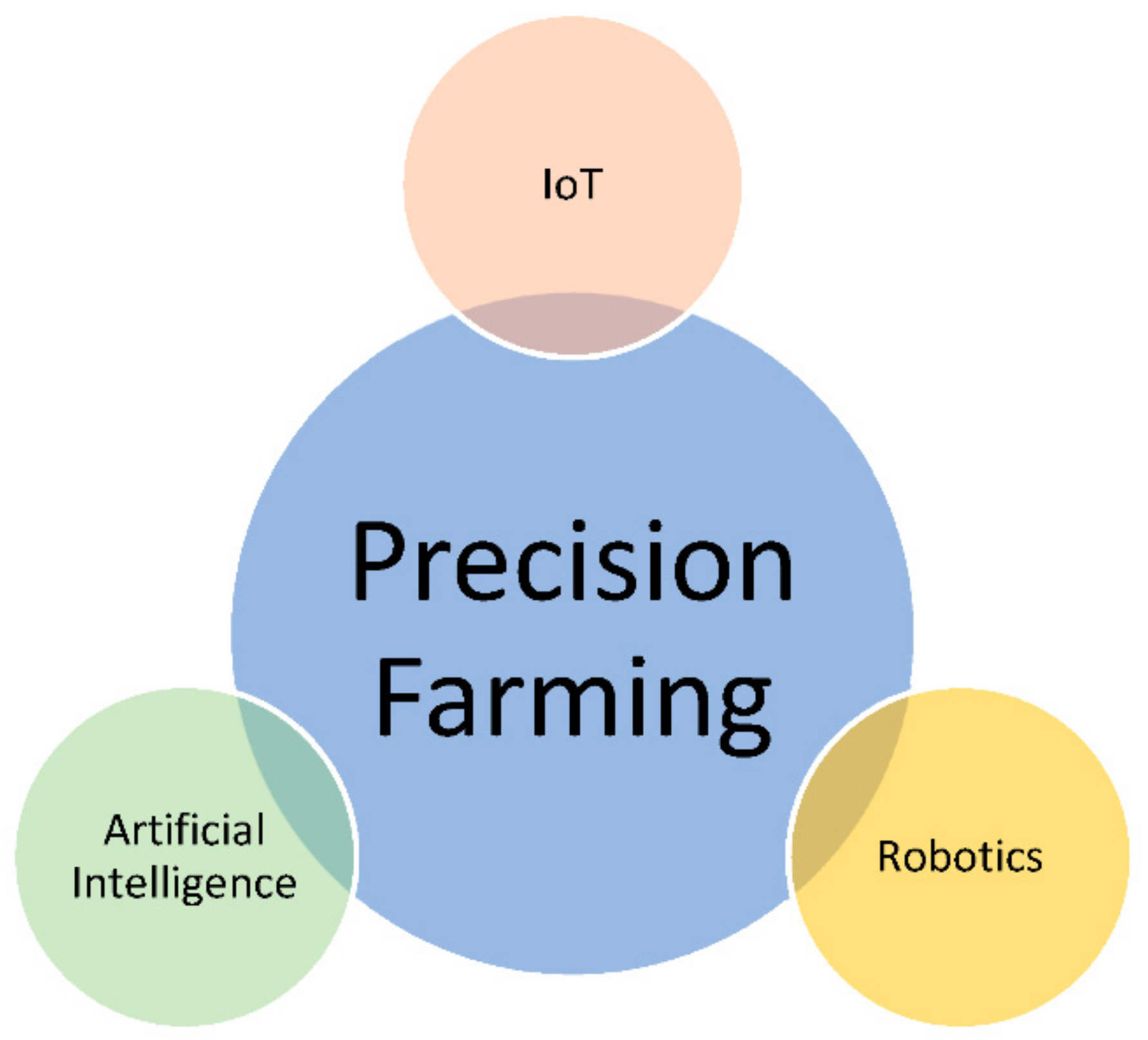
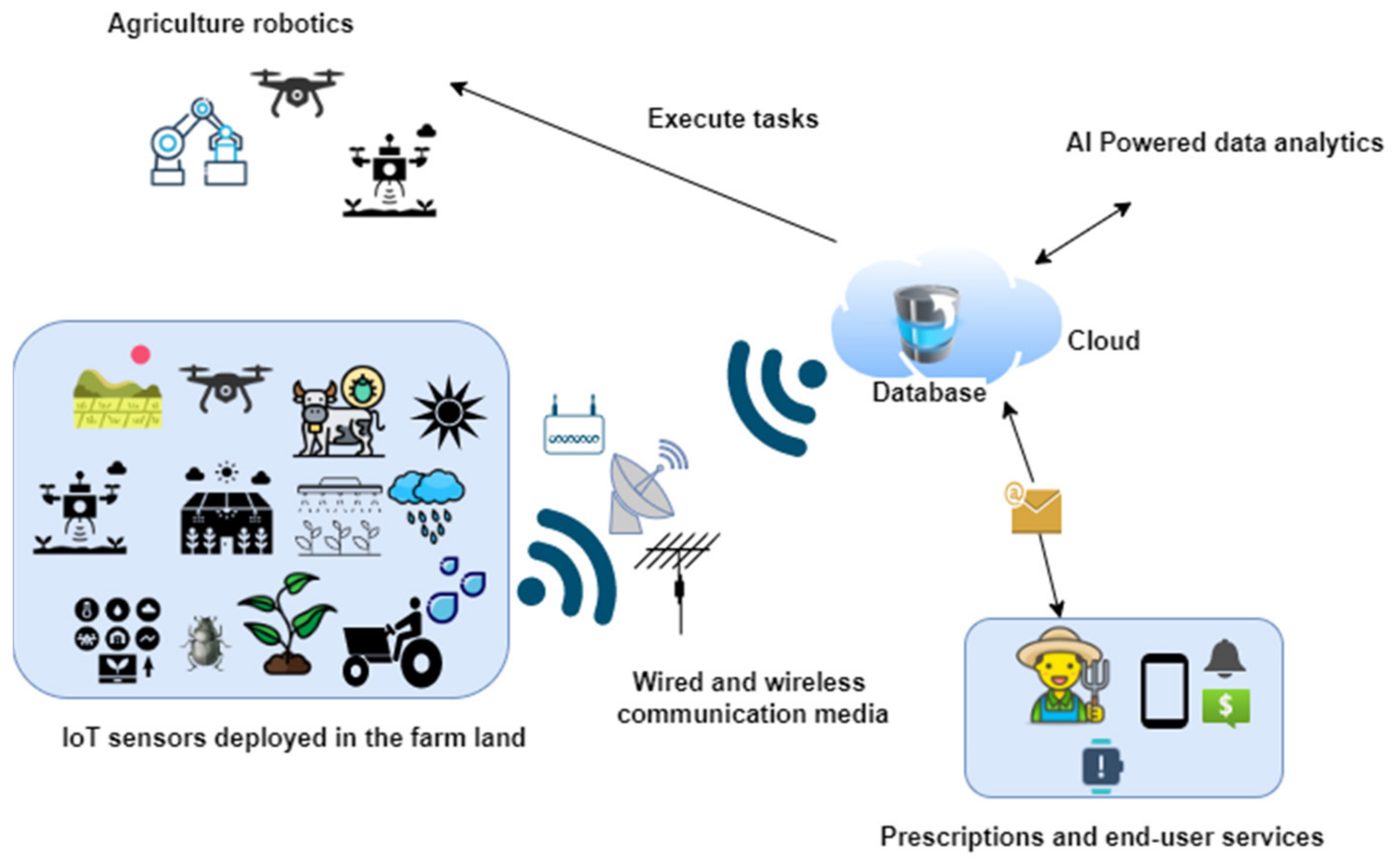

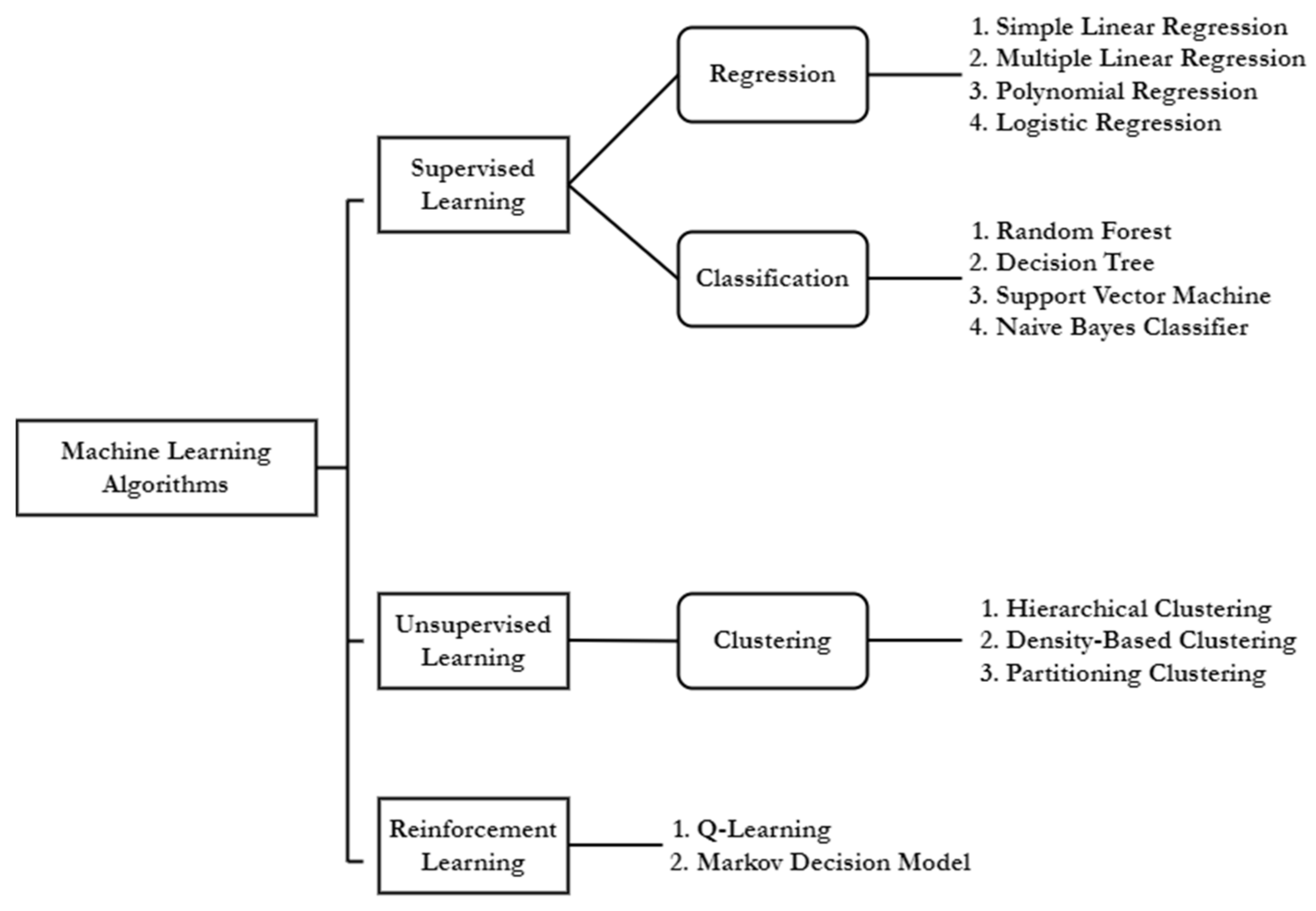
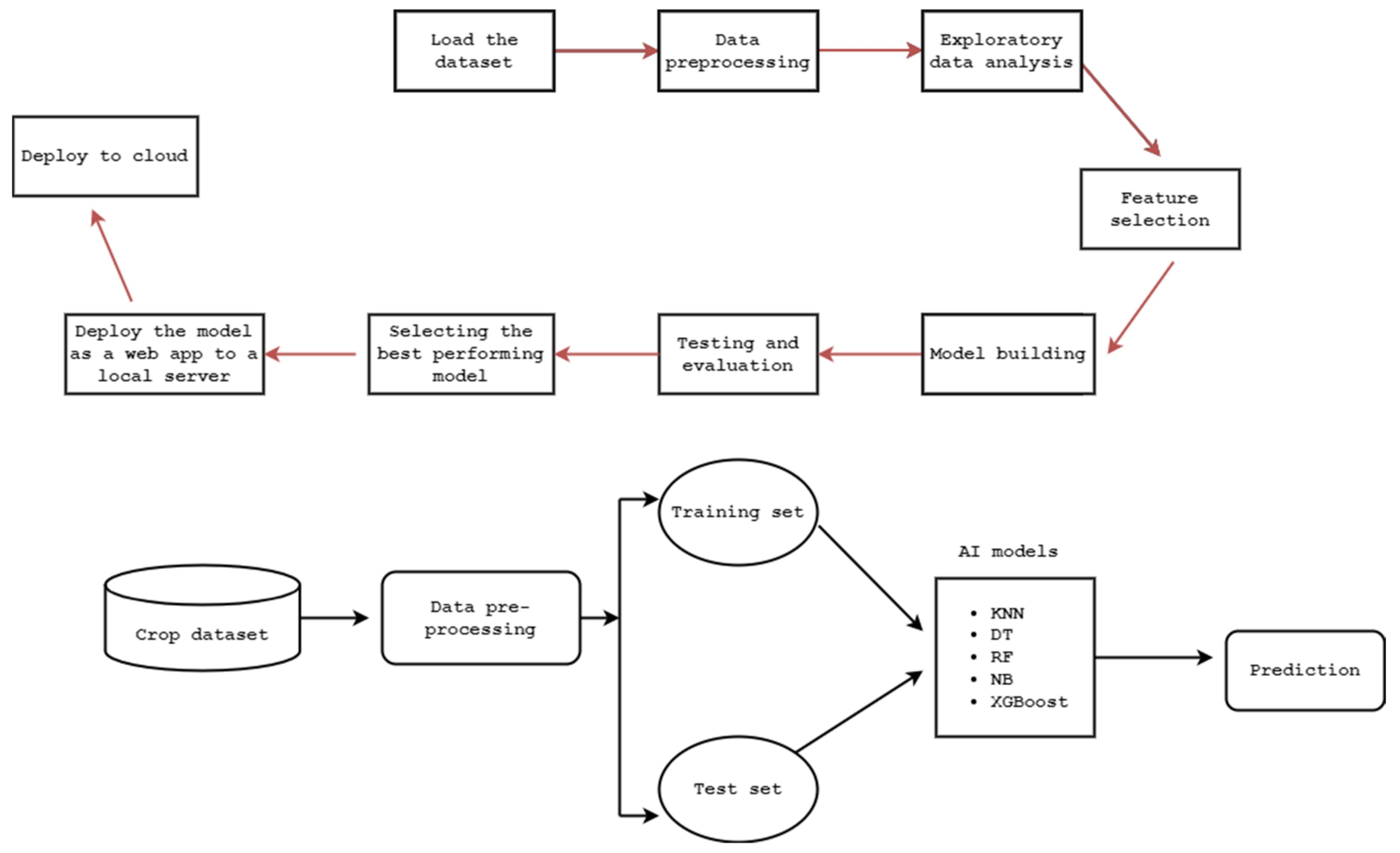
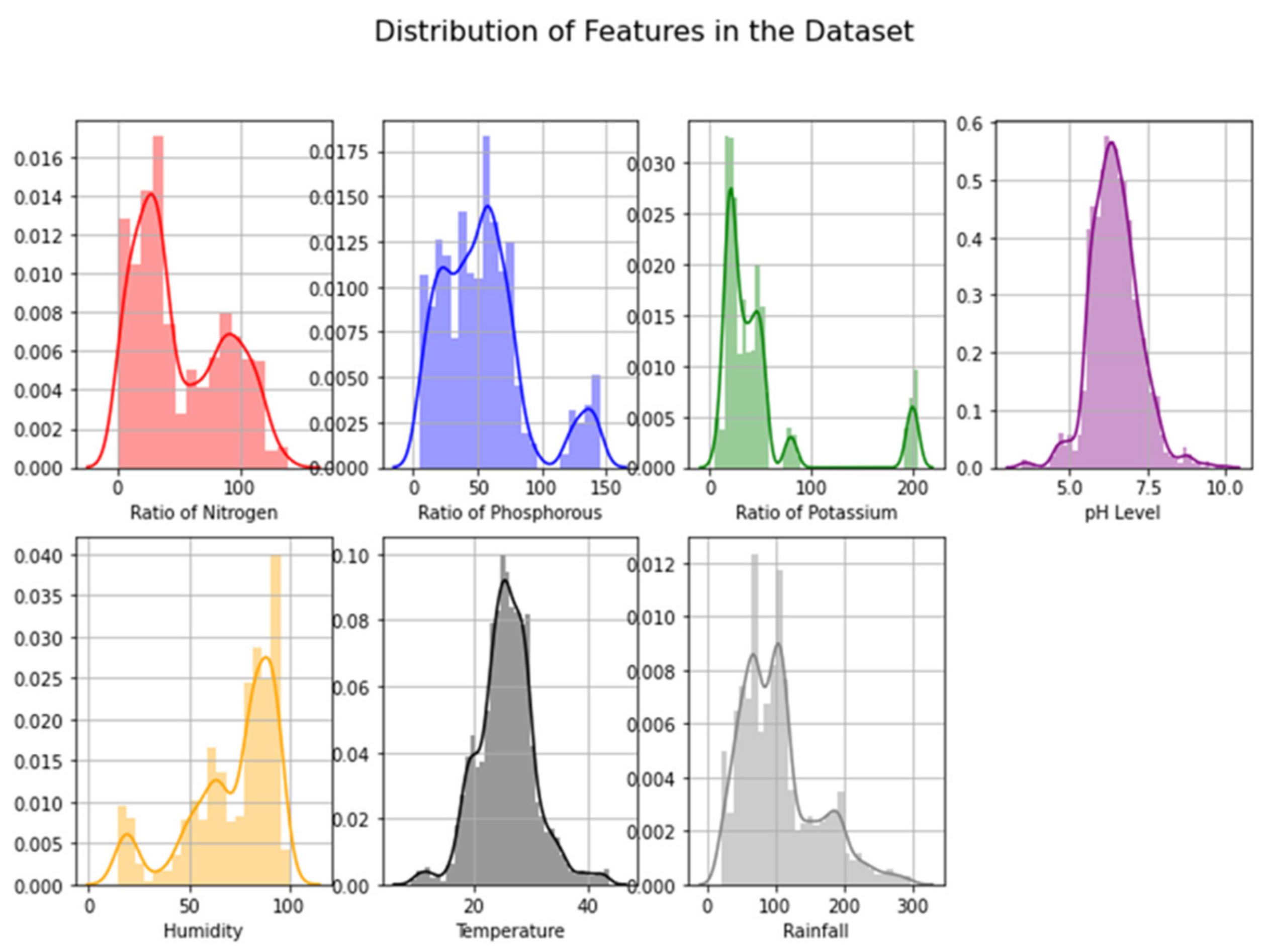


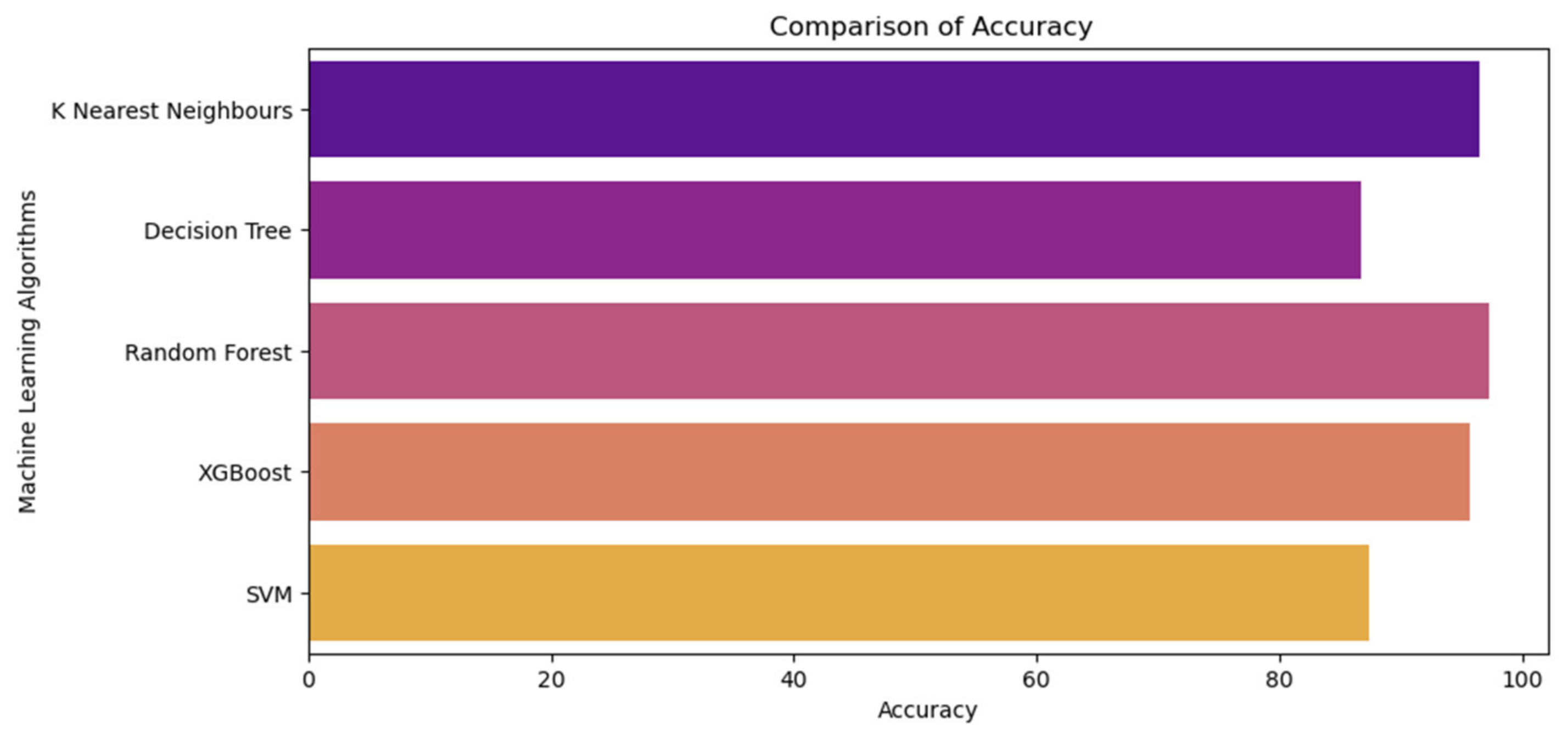
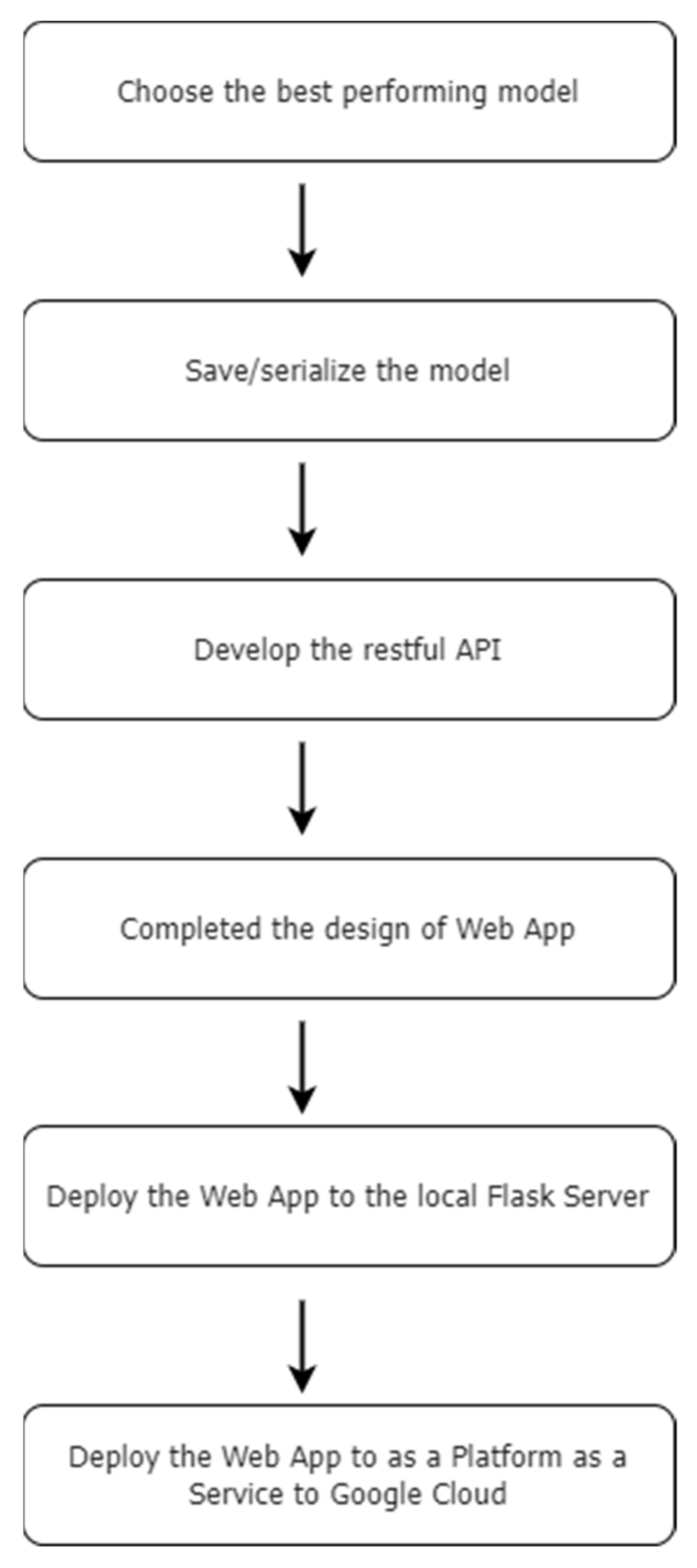
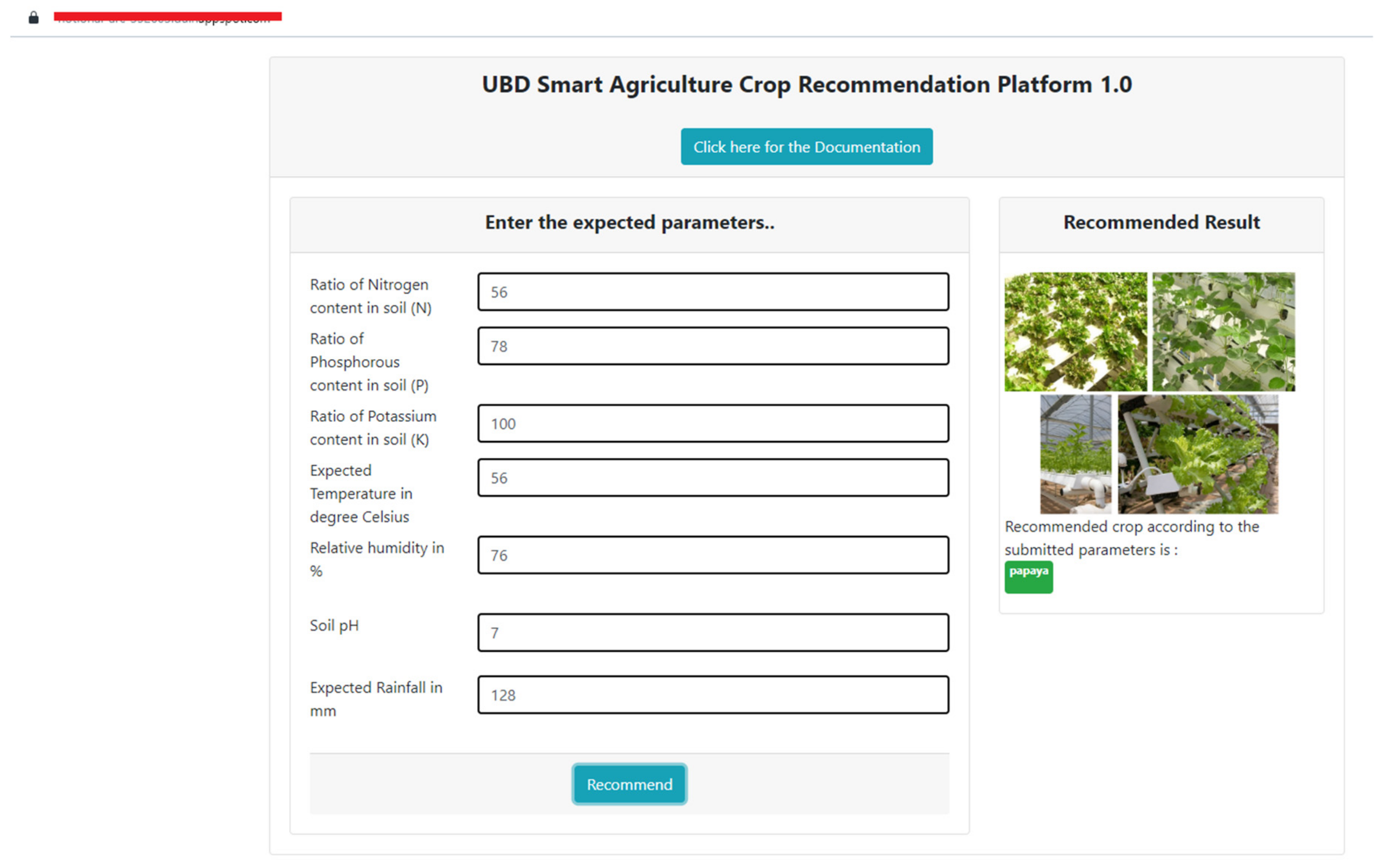

| Machine Learning Algorithm | Description |
|---|---|
| Regression algorithms | Regression algorithms are supervised learning algorithms that use training data to predict the output numerical value of unknown input. Some of the most frequent regression ML methods include simple and linear regression, polynomial regression, and logistic regression [1,3,7,12]. |
| Random Forest (RF) | RF is an ensemble learning methodology for classification and regression that works by constructing a jumble of decision trees at training time and outputting the category that is the mode of the categories or mean prediction of the individual trees [7,9,12]. |
| Decision Tree (DT) | DT is a classification and regression algorithm that works with both categorical and continuous input and output variables. It divides the data into two or more homogeneous sets or areas based on the independent variables’ most significant splitter [1,2,3,4,7,12]. |
| Support Vector Machine (SVM) | SVM is a classification and regression algorithm that creates multi-dimensional planes (boundaries) between data points in the feature space [7]. The SVM predicts the output based on the training data separated into classes and SVM is better suited to high-dimensional data with many predictor variables [1,2,3,12]. |
| K-Nearest Neighbors (KNN) | KNN is a supervised learning algorithm that divides a labeled dataset into classes depending on its outputs. As a result, a new forthcoming item is given a class depending on its K nearest neighbors [3,4,5,6,7,9,12]. |
| Naive Bayes (NB) | A Naive Bayes classifier is a probabilistic machine learning model for classification problems. The Bayes theorem is the foundation of the classifier [1,2,3,4,7,12]. |
| Extreme Gradient Boosting (XGBoost) | XGBoost is a regression and classification algorithm built on the principles of gradient boosting framework [1,2,3,4,5,6,7,9,12]. |
| Clustering algorithms | In contrast to supervised learning, clustering algorithms automatically uncover natural grouping in data and can only interpret the input data and locate natural groups or clusters in feature space [7,9,12]. |
| Reference | Application Area/s | ML Algorithm/s Used | Research Contributions |
|---|---|---|---|
| Kumar et al. (2019) | Crop management | SVM, DT, Logistic Regression (LR) | The authors introduced an ML-powered recommendation system for identifying crop suitability and pest control. Further, they found that among the ML algorithms they used, SVM gave the best results as opposed to other algorithms. |
| Shinde et al. (2015) | Crop management | RF | The study proposed using data mining techniques to provide recommendations for what crops to grow, crop rotation, and fertilizer identification in the form of web-based and smart mobile applications. |
| Mahir et al. (2008) | Soil management | Neural Network (NN) | Considering the various parameters of the soil the authors presented a recommendation system for recommending what kind of crop to harvest in certain types of soil. |
| Arooj et al. (2018) | Soil management | NB, DT, NN, SVM | The authors provided an empirical study on various data mining classification algorithms to classify the datasets of different regions based on the soil properties. |
| Rajak et al. (2017) | Crop management and soil management | SVM, Artificial Neural Network (ANN) | The authors made a recommendation system to recommend crops for farming sites based on the type of soil, where they used data from a soil sampling lab to train their underlying ML models. |
| Pudumalar et al. (2017) | Crop management | KNN, NB, RF | The authors proposed an ensemble model with a majority voting technique to recommend crops according to site-specific parameters. |
| Alam et al. (2020) | Crop management | RF | The authors presented a real-time computer vision-based crop/weed detection system for variable-rate agrochemical spraying. |
| Brunelli et al. (2019) | Crop management | NN | The authors presented a near-sensor neural network algorithm that can automatically detect the Codling Moth in apple orchids. Once the insect is detected, the system itself performs classification and sends a real-time alert to the farmers. |
| Tsouros et al. (2019) | Crop management | - | The authors summarized the data acquisition methods and technologies for acquiring images in UAV-based precision farming in their study and provided a comparison. |
| Treboux and Genoud. (2019) | Crop management | DT, RF | The authors presented the performance of ML algorithms used in aerial image detection in precision farming. |
| Dimitriadis and Goumopoulos. (2008) | Water management | NB, ZeroR, OneR, J48, DecisionStump | ML techniques were used by the authors to automatically extract new knowledge in the form of generalized decision rules for the optimum management of natural resources such as water in farming land. |
| Reddy et al. (2020) | Water management | DT | The authors proposed a real-time smart irrigation system powered by the DT ML algorithm to alert ranchers in real time about when to supply water to the field. |
| Junior et al. (2022) | Crop management | K-Means Clustering | To reduce the data congestion when overloading IoT data to the cloud, the authors proposed an approach for collecting and storing data in a fog-based smart agriculture environment with different data reduction techniques. |
| Shukla et al. (2021) | Crop management | LR, KNN, SVM, RF, NN | The authors introduced an IoT and ML-powered platform capable of monitoring the condition of crops and crop disease detection. Moreover, the introduced system was also linked with UAV, and through the multispectral images captured through IoT integrated with UAV, the system was able to detect the health of crops in the field. |
| Petropoulos et al. (2020) | Crop management | Support Vector Regression (SVR), Random Forest Regression (RFR) | The authors proposed novel ML and DL techniques to predict yield and plant growth variation in controlled greenhouse environments. In this regard the authors have deployed Recurrent Neural Network (RNN), using the Long Short-Term Memory (LSTM) neuron model for the prediction and they have presented a comparative study using SVR and RFR ML models. |
| Agarwal and Tarar, (2021) | Crop management, Soil management | SVM | The authors provided a novel AI model for predicting the type of the crop to harvest based on the characteristics of the soil and in that regard, they have used SVM as the ML model and RNN and LSTM as DL algorithms. |
| Raja et al. (2018) | Crop management | Regression algorithms | The authors performed an experiment with past data to predict the crop yield and price that a farmer can obtain from his land using regression classification techniques. |
| Viviliya and Vaidhehi. (2019) | Crop management | NB, J48, Association rule learning | The authors proposed a hybrid crop recommendation system for recommending crops to South Indian states by considering various environmental attributes. |
| Goap et al. (2018) | Water management | K-Means clustering, SVR | The authors presented a novel open-source technology-based smart irrigation system that predicts irrigation requirements for fields using a variety of environmental parameters, in which they have came up with a novel algorithm for this purpose. |
| Brock et al. (2018) | Livestock management | Self-organizing maps | The authors presented a new approach for classifying herd types in livestock systems by combining expert knowledge and a machine-learning algorithm known as self-organizing maps (SOMs), which they applied practically to the cattle sector in Ireland, in order to understand ongoing discussions surrounding control and surveillance for endemic cattle diseases. |
| Lee, M. (2018) | Livestock management | RF, Expectation maximization | This study proposed and implemented a system to analyze 3-axis acceleration data from IoT sensors and compared the pattern-recognition performance of machine-learning algorithms for three breeding cow behavioral patterns: estrus start, peak estrus activities, and estrus finish. |
| Statistics | N | P | K | Air Temperature | Air Humidity | Soil pH | Rainfall |
|---|---|---|---|---|---|---|---|
| Entries | 2200 | 2200 | 2200 | 2200 | 2200 | 2200 | 2200 |
| Mean | 50.55 | 53.36 | 48.14 | 25.61 | 71.48 | 6.47 | 103.50 |
| Standard Deviation | 36.91 | 32.98 | 50.64 | 5.06 | 22.26 | 0.77 | 54.95 |
| Minimum | 0.00 | 5.00 | 5.00 | 8.82 | 14.25 | 3.50 | 20.21 |
| Maximum | 140.00 | 145.00 | 205.00 | 43.67 | 99.98 | 9.93 | 298.56 |
| Model | Accuracy Score | Precision Score | Recall Score | F1 Score | K-Fold Cross Validation Score (K-10) |
|---|---|---|---|---|---|
| KNN | 96.36% | 97% | 96% | 96% | 97% |
| DT | 86.64% | 82% | 87% | 83% | 92% |
| RF | 97.18% | 97% | 97% | 97% | 97.40% |
| XGBoost | 95.62% | 96% | 96% | 96% | 96.31% |
| SVM | 87.38% | 87% | 87% | 87% | 88.50% |
| Software | Key Features | Development Mode | Web Link |
|---|---|---|---|
| AgroSense [44] | Soil health tracking, overall planning, and budgeting | OpenAPI (this makes the application programming interface publicly available to software developers) | https://agrosense.eu (accessed on 5 June 2022). |
| Tania [45] | Planning and budgeting, labor planning | OpenAPI | https://usetania.org (accessed on 5 June 2022). |
| farmOS [46] | Crop management, labor management, order management | OpenAPI | https://farmos.org (accessed on 5 June 2022). |
| LiteFarm [47] | Crop management | OpenAPI | https://www.litefarm.org (accessed on 5 June 2022). |
| Granular Insights (even though this is free, it is not an open-source solution) [48] | Crop management, labor management, order processing | Cloud hosted | https://granular.ag/granular-insights/ (accessed on 5 June 2022). |
Publisher’s Note: MDPI stays neutral with regard to jurisdictional claims in published maps and institutional affiliations. |
© 2022 by the authors. Licensee MDPI, Basel, Switzerland. This article is an open access article distributed under the terms and conditions of the Creative Commons Attribution (CC BY) license (https://creativecommons.org/licenses/by/4.0/).
Share and Cite
Thilakarathne, N.N.; Bakar, M.S.A.; Abas, P.E.; Yassin, H. A Cloud Enabled Crop Recommendation Platform for Machine Learning-Driven Precision Farming. Sensors 2022, 22, 6299. https://doi.org/10.3390/s22166299
Thilakarathne NN, Bakar MSA, Abas PE, Yassin H. A Cloud Enabled Crop Recommendation Platform for Machine Learning-Driven Precision Farming. Sensors. 2022; 22(16):6299. https://doi.org/10.3390/s22166299
Chicago/Turabian StyleThilakarathne, Navod Neranjan, Muhammad Saifullah Abu Bakar, Pg Emerolylariffion Abas, and Hayati Yassin. 2022. "A Cloud Enabled Crop Recommendation Platform for Machine Learning-Driven Precision Farming" Sensors 22, no. 16: 6299. https://doi.org/10.3390/s22166299
APA StyleThilakarathne, N. N., Bakar, M. S. A., Abas, P. E., & Yassin, H. (2022). A Cloud Enabled Crop Recommendation Platform for Machine Learning-Driven Precision Farming. Sensors, 22(16), 6299. https://doi.org/10.3390/s22166299







